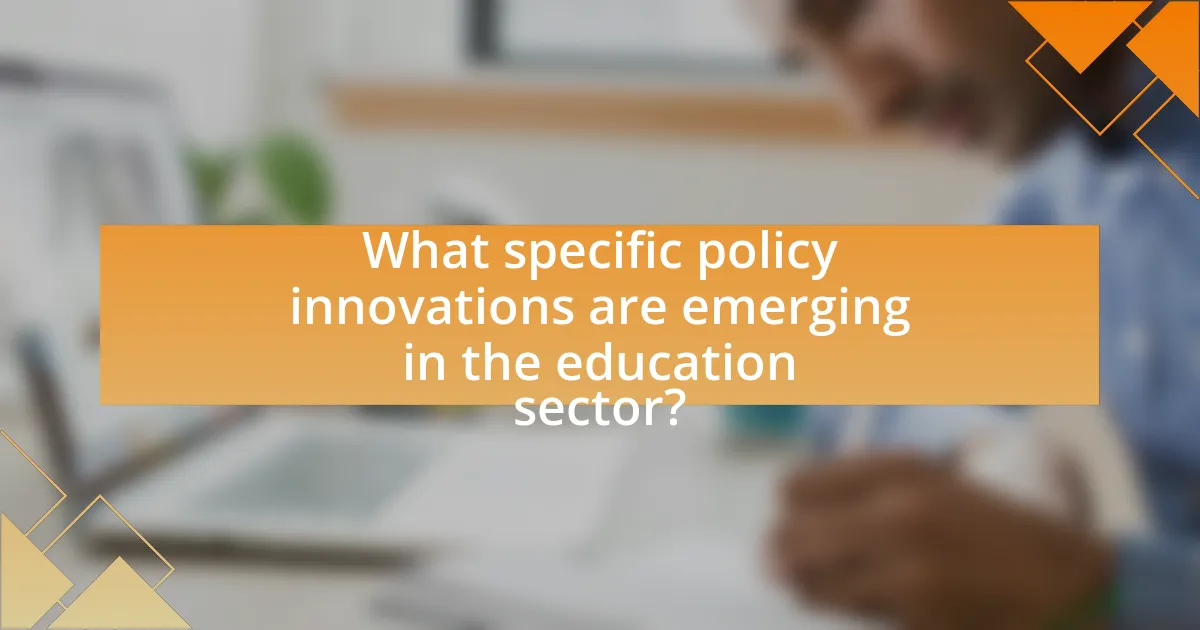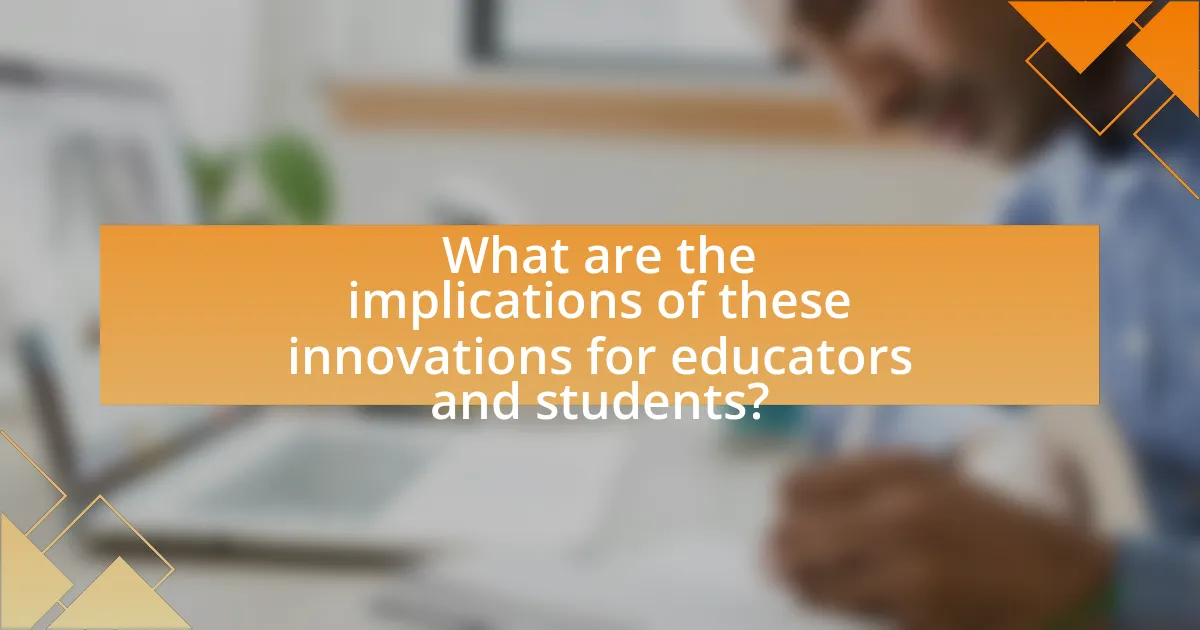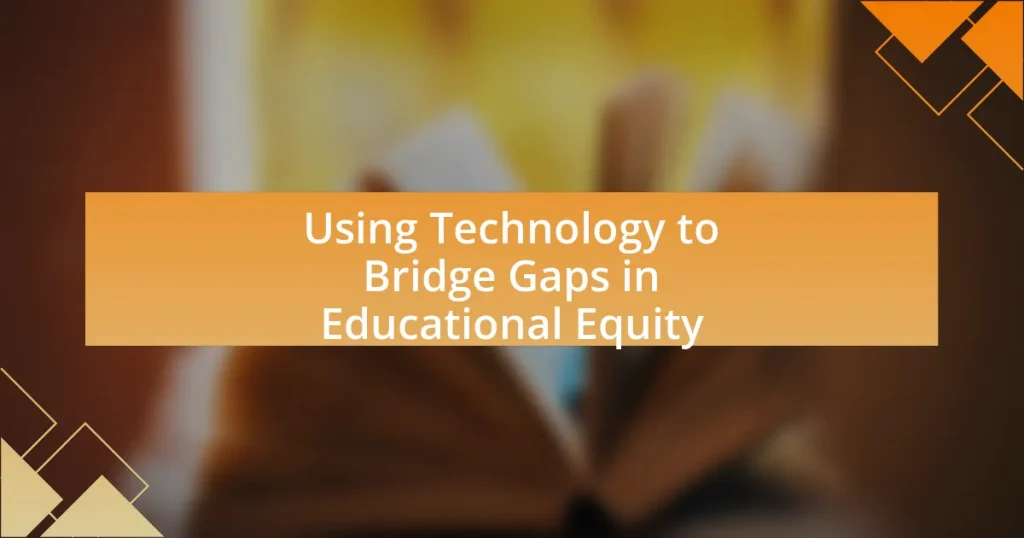The article focuses on the future of educational equity in a post-pandemic world, emphasizing the need for policy innovations to address disparities exacerbated by the COVID-19 crisis. It highlights how the pandemic has widened the achievement gap, particularly affecting low-income and marginalized students who faced significant barriers to remote learning. Key discussions include the role of technology in promoting equitable access, the importance of targeted funding and community partnerships, and the necessity of integrating social-emotional support into educational frameworks. The article also explores proposed funding models and strategies for educators and families to navigate the evolving educational landscape, ultimately advocating for sustainable practices to ensure equitable educational opportunities for all students.

What is the Future of Educational Equity in a Post-Pandemic World?
The future of educational equity in a post-pandemic world is likely to focus on integrating technology and personalized learning to address disparities. Research indicates that the pandemic has exacerbated existing inequalities, with students from low-income backgrounds facing significant barriers to access quality education. For instance, a report by the National Center for Education Statistics shows that students in high-poverty schools were less likely to have access to the necessary technology for remote learning. As a result, future policies may prioritize funding for digital infrastructure and training for educators to ensure all students can benefit from equitable learning opportunities. Additionally, initiatives aimed at social-emotional support and mental health resources will be crucial in addressing the holistic needs of students affected by the pandemic.
How has the pandemic impacted educational equity?
The pandemic has exacerbated educational inequity by widening the achievement gap between students from different socioeconomic backgrounds. Research indicates that students from low-income families faced significant barriers to remote learning, including lack of access to technology and a conducive learning environment, which hindered their academic progress. For instance, a report by the National Bureau of Economic Research found that students in low-income areas experienced a 30% decline in learning compared to their higher-income peers during the pandemic. This disparity highlights the urgent need for policy innovations to address these inequities in a post-pandemic educational landscape.
What disparities in education have been highlighted by the pandemic?
The pandemic has highlighted significant disparities in education, particularly in access to technology and resources. For instance, a report from the Pew Research Center indicated that 59% of lower-income parents reported their children faced challenges with online learning due to a lack of reliable internet access or devices. Additionally, students from marginalized communities experienced greater learning loss, as evidenced by a study from McKinsey & Company, which found that Black and Hispanic students fell behind their peers by 6 to 12 months in academic progress during the pandemic. These disparities underscore the urgent need for policy innovations to address educational equity in a post-pandemic world.
How have different demographics been affected by these disparities?
Different demographics have been affected by educational disparities in significant ways, particularly along lines of race, socioeconomic status, and geographic location. For instance, students from low-income families experienced greater learning loss during the pandemic, with research indicating that they fell behind by an average of 3 to 5 months in reading and 5 to 7 months in math compared to their higher-income peers. Additionally, Black and Hispanic students faced disproportionate challenges, with a study from the National Bureau of Economic Research showing that these groups were more likely to attend schools with fewer resources and less access to technology, exacerbating existing inequalities. Rural students also encountered unique barriers, such as limited internet access, which hindered their ability to engage in remote learning effectively.
What role do policy innovations play in promoting educational equity?
Policy innovations play a crucial role in promoting educational equity by addressing systemic barriers and creating inclusive frameworks for diverse student populations. These innovations, such as targeted funding initiatives, equitable resource allocation, and inclusive curriculum reforms, aim to level the playing field for underrepresented and disadvantaged groups. For instance, the Every Student Succeeds Act (ESSA) emphasizes state accountability for educational outcomes, which has led to increased support for low-income schools and marginalized communities. Research indicates that such policy changes can significantly improve access to quality education, thereby reducing achievement gaps and fostering a more equitable educational landscape.
What types of policy innovations are being proposed?
Proposed policy innovations for educational equity in a post-pandemic world include increased funding for digital infrastructure, expanded access to mental health services, and the implementation of universal basic income for families with school-aged children. Increased funding for digital infrastructure aims to bridge the digital divide, ensuring all students have access to online learning resources, which is critical given the shift to remote education during the pandemic. Expanded access to mental health services addresses the heightened emotional and psychological needs of students resulting from pandemic-related disruptions. Universal basic income initiatives are designed to alleviate financial stress on families, thereby enabling students to focus on their education without the burden of economic instability. These innovations are supported by research indicating that equitable access to resources and support systems significantly enhances educational outcomes.
How can these policies address existing inequities?
These policies can address existing inequities by implementing targeted funding and resources to underprivileged schools, ensuring equitable access to quality education. For instance, research indicates that increased funding in low-income districts leads to improved student outcomes, as seen in the 2018 study by the National Bureau of Economic Research, which found that additional resources significantly narrowed achievement gaps. By prioritizing investments in marginalized communities, these policies can create a more level playing field, ultimately fostering educational equity.
Why is educational equity crucial for future generations?
Educational equity is crucial for future generations because it ensures that all students, regardless of their background, have access to the same quality of education and opportunities for success. This equitable access leads to improved academic outcomes, which are essential for economic mobility and social cohesion. Research indicates that equitable education systems can reduce achievement gaps; for instance, a study by the National Center for Education Statistics found that students from disadvantaged backgrounds who receive equitable resources perform better academically than those who do not. Therefore, prioritizing educational equity is vital for fostering a more just and prosperous society for future generations.
What are the long-term effects of inequitable education?
The long-term effects of inequitable education include persistent socioeconomic disparities, reduced access to higher education, and diminished workforce productivity. Research indicates that students from underfunded schools often score lower on standardized tests, leading to fewer opportunities for advanced education and career advancement. For instance, a study by the National Center for Education Statistics found that students in high-poverty schools are significantly less likely to graduate from high school compared to their peers in affluent areas. This educational gap contributes to a cycle of poverty, where individuals from disadvantaged backgrounds struggle to achieve economic stability, perpetuating inequality across generations.
How does educational equity contribute to societal well-being?
Educational equity contributes to societal well-being by ensuring that all individuals have access to quality education, which fosters economic growth and social cohesion. When educational opportunities are equitable, diverse populations can develop skills that meet labor market demands, leading to increased productivity and innovation. For instance, research from the National Center for Education Statistics indicates that higher educational attainment correlates with lower unemployment rates and higher earnings, which in turn enhances community stability and reduces poverty levels. Furthermore, equitable education promotes social mobility, allowing individuals from disadvantaged backgrounds to improve their circumstances, thereby contributing to a more equitable society overall.
How can we measure the effectiveness of policy innovations in education?
To measure the effectiveness of policy innovations in education, one can utilize a combination of quantitative and qualitative metrics, including standardized test scores, graduation rates, and stakeholder surveys. Quantitative metrics provide objective data on student performance and educational outcomes, while qualitative metrics offer insights into the experiences and perceptions of students, teachers, and parents regarding the implemented policies. For instance, a study by the National Center for Education Statistics found that states implementing innovative assessment methods saw a 10% increase in student engagement and performance, demonstrating a direct correlation between policy changes and educational outcomes.
What challenges do policymakers face in implementing these innovations?
Policymakers face significant challenges in implementing innovations aimed at enhancing educational equity in a post-pandemic world. These challenges include limited funding, which restricts the ability to scale new programs effectively, as evidenced by a report from the National Education Association indicating that many districts lack the financial resources to adopt comprehensive reforms. Additionally, resistance to change from various stakeholders, including educators and parents, complicates the adoption of new policies, as highlighted in research by the Brookings Institution, which found that stakeholder buy-in is crucial for successful implementation. Furthermore, disparities in technology access among students create barriers to equitable educational opportunities, with the Pew Research Center reporting that 15% of U.S. households with school-age children do not have high-speed internet, hindering the effectiveness of digital innovations.

What specific policy innovations are emerging in the education sector?
Specific policy innovations emerging in the education sector include the implementation of universal basic income for students, expanded access to digital learning resources, and the integration of social-emotional learning into curricula. Universal basic income initiatives, such as those piloted in various districts, aim to alleviate financial barriers for low-income families, thereby promoting educational equity. The expansion of digital learning resources has been accelerated by the pandemic, with many schools adopting blended learning models that provide students with greater access to online materials and tools. Additionally, the integration of social-emotional learning into curricula is gaining traction, as research indicates that such programs can improve student well-being and academic performance, fostering a more supportive educational environment.
How are technology and digital learning reshaping educational equity?
Technology and digital learning are reshaping educational equity by providing greater access to resources and personalized learning experiences for diverse student populations. Online platforms and digital tools enable students from various backgrounds, including those in underserved communities, to access high-quality educational materials and instruction that were previously unavailable to them. For instance, a report by the National Center for Education Statistics indicates that during the COVID-19 pandemic, schools that utilized technology effectively were able to maintain engagement and learning continuity, highlighting the role of digital tools in bridging educational gaps. Furthermore, adaptive learning technologies can tailor educational content to meet individual student needs, thereby promoting inclusivity and equity in learning outcomes.
What are the benefits of integrating technology in education?
Integrating technology in education enhances learning outcomes, increases accessibility, and fosters engagement. Research indicates that technology can personalize learning experiences, allowing students to progress at their own pace, which has been shown to improve retention rates. For instance, a study by the Bill & Melinda Gates Foundation found that adaptive learning technologies can lead to a 20% increase in student performance. Additionally, technology provides access to a wealth of resources and information, bridging gaps for students in underserved areas. The use of digital tools also encourages collaboration and communication among students, which is essential for developing critical thinking and problem-solving skills.
What barriers exist in accessing digital learning resources?
Barriers in accessing digital learning resources include lack of internet connectivity, inadequate technological devices, and digital literacy challenges. According to a report by the Pew Research Center, approximately 14% of U.S. households with school-age children do not have a high-speed internet connection, which significantly limits access to online educational materials. Additionally, many students lack access to necessary devices, with a study from the National Center for Education Statistics indicating that 15% of students do not have a computer at home. Furthermore, digital literacy varies widely, with a survey by the International Telecommunication Union revealing that 48% of individuals in developing countries lack basic digital skills, hindering their ability to effectively utilize online learning resources.
What funding models are being explored to support educational equity?
Funding models being explored to support educational equity include weighted student funding, community schools funding, and public-private partnerships. Weighted student funding allocates resources based on individual student needs, ensuring that disadvantaged students receive additional support. Community schools funding integrates educational services with community resources, promoting holistic support for students and families. Public-private partnerships leverage private investment to enhance educational resources and infrastructure, aiming to close equity gaps. These models are being implemented in various districts across the United States, demonstrating their potential to address disparities in educational access and outcomes.
How can equitable funding models be designed?
Equitable funding models can be designed by implementing a needs-based allocation system that considers the socioeconomic status of students and the specific challenges faced by schools. This approach ensures that resources are distributed in a manner that addresses disparities, allowing underfunded schools to receive additional support based on factors such as student poverty rates, special education needs, and English language proficiency. Research from the Education Trust highlights that states that adopt weighted funding formulas, which allocate more funds to schools serving higher numbers of disadvantaged students, can significantly improve educational outcomes and reduce achievement gaps.
What examples of successful funding initiatives exist?
Successful funding initiatives include the “Every Student Succeeds Act” (ESSA), which allocates federal funding to support educational equity across states, and the “Student Support and Academic Enrichment Grants,” which provide resources for improving educational opportunities. ESSA has led to increased funding for low-income schools, resulting in improved student outcomes, while the Student Support Grants have funded programs that enhance mental health services and access to advanced coursework. These initiatives demonstrate effective allocation of resources aimed at reducing disparities in education.
How are community partnerships influencing educational equity?
Community partnerships are significantly influencing educational equity by providing resources, support, and advocacy that address systemic disparities in education. These collaborations often involve schools, local organizations, businesses, and families working together to create tailored programs that meet the specific needs of underserved communities. For instance, research from the National Education Association indicates that schools with strong community partnerships report improved student outcomes, including higher graduation rates and increased access to advanced coursework. By leveraging local knowledge and resources, these partnerships help to dismantle barriers to education, ensuring that all students have equitable opportunities to succeed.
What role do local organizations play in supporting schools?
Local organizations play a crucial role in supporting schools by providing resources, mentorship, and community engagement. These organizations often collaborate with schools to enhance educational programs, offer after-school activities, and supply essential materials that may be lacking due to budget constraints. For instance, a study by the National Center for Education Statistics found that partnerships with local nonprofits can lead to improved student outcomes, including higher attendance rates and better academic performance. Additionally, local organizations can facilitate professional development for teachers, ensuring that educators are equipped with the latest strategies and tools to support diverse learners.
How can collaboration enhance educational outcomes?
Collaboration can enhance educational outcomes by fostering a supportive learning environment that encourages diverse perspectives and shared resources. When educators, students, and communities work together, they can create tailored learning experiences that address individual needs, leading to improved engagement and achievement. Research indicates that collaborative learning strategies, such as peer tutoring and group projects, can significantly boost student performance; for instance, a study published in the “Journal of Educational Psychology” found that students who participated in collaborative learning scored higher on assessments compared to those who learned independently. This evidence underscores the effectiveness of collaboration in driving educational success.

What are the implications of these innovations for educators and students?
The implications of innovations for educators and students include enhanced access to resources and personalized learning experiences. These innovations, such as digital platforms and adaptive learning technologies, enable educators to tailor instruction to individual student needs, improving engagement and outcomes. For instance, a study by the Bill & Melinda Gates Foundation found that personalized learning can lead to significant gains in student achievement, particularly for underserved populations. Additionally, these innovations facilitate collaboration among educators, allowing for the sharing of best practices and resources, which can further enhance teaching effectiveness. Overall, the integration of these innovations supports a more equitable educational landscape, addressing disparities exacerbated by the pandemic.
How can educators adapt to new policies and innovations?
Educators can adapt to new policies and innovations by engaging in continuous professional development and collaborating with peers. Continuous professional development allows educators to stay informed about the latest educational policies and teaching strategies, which is crucial in a rapidly changing educational landscape. Collaboration with peers fosters the sharing of best practices and resources, enhancing the implementation of new policies. Research indicates that schools that prioritize professional development and collaborative practices see improved student outcomes and teacher satisfaction, as highlighted in the report “Professional Development in Education: A Review of the Evidence” by Timperley et al. (2007).
What training and resources do educators need?
Educators need professional development training focused on digital literacy, culturally responsive teaching, and trauma-informed practices. This training equips educators with the skills to effectively engage diverse student populations and address the challenges posed by the pandemic. Research indicates that ongoing professional development significantly improves teaching effectiveness and student outcomes, as highlighted in the report “Effective Teacher Professional Development” by the National Center for Education Evaluation and Regional Assistance, which emphasizes the importance of targeted training in enhancing educator competencies. Additionally, access to resources such as technology tools, mental health support services, and collaborative platforms is essential for fostering an equitable learning environment. These resources enable educators to implement innovative teaching strategies and support student well-being, ultimately contributing to educational equity in a post-pandemic context.
How can educators advocate for equitable practices in their schools?
Educators can advocate for equitable practices in their schools by actively promoting inclusive curricula and fostering a culture of diversity. This involves implementing teaching strategies that recognize and address the varied backgrounds and learning needs of all students. Research indicates that schools with inclusive practices see improved academic outcomes and social cohesion among students. For instance, a study by the National Center for Education Statistics found that schools emphasizing equity and inclusion report higher student engagement and lower dropout rates. By collaborating with community stakeholders and participating in professional development focused on equity, educators can further enhance their advocacy efforts, ensuring that all students receive the support they need to succeed.
What strategies can students and families employ to navigate these changes?
Students and families can employ strategies such as leveraging technology for remote learning, engaging in community support networks, and advocating for equitable resources to navigate changes in education. Utilizing technology allows students to access online resources and participate in virtual classes, which has become essential post-pandemic. Community support networks, including local organizations and peer groups, provide emotional and academic assistance, fostering a collaborative environment. Advocacy for equitable resources ensures that all students have access to necessary tools and support, addressing disparities highlighted during the pandemic. These strategies collectively empower families to adapt effectively to the evolving educational landscape.
How can families support their children’s education in a changing landscape?
Families can support their children’s education in a changing landscape by actively engaging in their learning processes and fostering a supportive home environment. This includes establishing consistent routines for studying, encouraging open communication about school experiences, and utilizing available educational resources, such as online learning platforms and community programs. Research indicates that parental involvement significantly enhances student achievement; for instance, a study by the National Education Association found that students with engaged parents are more likely to earn higher grades and have better attendance. By prioritizing education and adapting to new learning modalities, families can effectively contribute to their children’s academic success in an evolving educational landscape.
What resources are available for families to promote educational equity?
Families can access various resources to promote educational equity, including community organizations, educational grants, and online platforms. Community organizations often provide support services, tutoring, and advocacy for underrepresented students, helping to bridge gaps in educational access. Educational grants, such as those from the U.S. Department of Education, offer funding for programs aimed at improving educational opportunities for disadvantaged families. Online platforms, like Khan Academy and Coursera, provide free educational resources and courses that can supplement learning at home, ensuring that all students have access to quality educational materials regardless of their background.
What best practices can be adopted to ensure sustainable educational equity?
To ensure sustainable educational equity, adopting a multi-faceted approach that includes equitable funding, inclusive curriculum design, and community engagement is essential. Equitable funding ensures that schools in underserved areas receive adequate resources, which is supported by the fact that research shows that increased funding leads to improved student outcomes, particularly in low-income communities. Inclusive curriculum design promotes diverse perspectives and culturally relevant materials, which has been shown to enhance student engagement and achievement, as evidenced by studies indicating that students perform better when they see their identities reflected in their education. Community engagement fosters partnerships between schools and local organizations, which can provide additional support and resources, as demonstrated by successful initiatives that have improved educational access and success rates in various districts.



